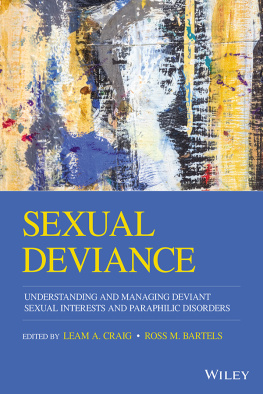First published in 1984 by Garland Publishing, Inc.
This edition first published in 2016
by Routledge
2 Park Square, Milton Park, Abingdon, Oxon OX14 4RN
711 Third Avenue, New York, NY 10017
Routledge is an imprint of the Taylor & Francis Group, an informa business
1984 Nanette J. Davis and Jone M. Keith
All rights reserved. No part of this book may be reprinted or reproduced or utilised in any form or by any electronic, mechanical, or other means, now known or hereafter invented, including photocopying and recording, or in any information storage or retrieval system, without permission in writing from the publishers.
Trademark notice: Product or corporate names may be trademarks or registered trademarks, and are used only for identification and explanation without intent to infringe.
British Library Cataloguing in Publication Data
A catalogue record for this book is available from the British Library
ISBN: 978-1-138-18723-8 (Set)
ISBN: 978-1-315-64317-5 (Set) (ebk)
ISBN: 978-1-138-18640-8 (Volume 1) (hbk)
ISBN: 978-1-315-64390-8 (Volume 1) (ebk)
Publishers Note
The publisher has gone to great lengths to ensure the quality of this reprint but points out that some imperfections in the original copies may be apparent.
Disclaimer
The publisher has made every effort to trace copyright holders and would welcome correspondence from those they have been unable to trace.
1984 Nanette J. Davis and Jone M. Keith All rights reserved
Library of Congress Cataloging in Publication Data
Davis, Nanette J.
Woman and deviance.
(Applied social science bibliographies; vol. 1)
(Garland reference library of social science; vol. 157)
Includes index.
1. WomenUnited StatesSocial conditionsBibliography. 2. Deviant behaviorBibliography. 3. Social controlBibliography. 4. WomenCrimes againstUnited StatesBibliography. I. Keith, Jone M. II. Title. III. Series. IV. Series: Garland reference library of social science; v. 157.
Z7964.U49D38 1984 [HQ1420] 016.30540973 82-49164
ISBN 0-8240-9165-5 (alk. paper)
Cover design by Laurence Walczak
Printed on acid-free, 250-year-life paper
Manufactured in the United States of America
In traditional social science and applied disciplines, such as sociology, criminology, psychology, anthropology, history, political science, and social work, the penetration of a sex/gender role analysis into these fields domain assumptions has affected the theory, content, methods, and styles of research. The outpourings from both the new feminist-centered literature and these disciplines provide theories and findings on womens roles that challenge firmly held beliefs about what is natural and normal. Women as a social category may be the last modern population explained by scholars and practitioners alike as products of either their biology or of natural law. The books reviewed here refute these patriarchal assumptions and raise questions about the meanings of deviance and social control for women and society.
This book is a selective, annotated bibliography on women and deviance that includes historical, cross cultural, sociological, psychological, political, legal, philosophical, and social policy perspectives. Limited to works primarily published in the United States, the book is concerned with the origins, change, conflict, and consequences of deviant behavior and womens adaptation to their changing roles. It encompasses monographs, journal articles, books, and government documents in English. Emphasis is on works published since 1970 although some significant work published in the 1960s or earlier has been included.
Because of the vast number of works that relate directly or tangentially to the issues of women and deviance, we excluded the following subject areas:
(1) works that are predominantly economic or deal with women in the labor force, such as Valerie K. Oppenheimer, The Female Labor Force in the United States (Westport, Conn.: Greenwood Press, 1982).
(2) works that are essentially concerned with contemporary feminist politics or are popular versions of womens problems, such as, Kate Milletts Sexual Politics (Garden City, New York: Doubleday, 1970), and Colette Dowling, The Cinderella Complex: Womens Hidden Fear of Independence (New York: Pocket Books, 1981).
(3) works that focus on normative sexuality, whether written from the experts point of view or the feminist perspective. In the latter case, an example is Jeannine Parvati, Hygieia: a Womans Herbal (San Francisco: A Freestone Collective, Peter G. Levison, Associates, distributors, 1978).
(4) literary or biographical works that offer literary criticism of womens scholarly or creative accomplishments. Examples in this genre are Laurie Lisle, Portrait of an Artist: A Biography of Georgia OKeefe (New York: Simon and Schuster, Pocket Books, 1980), and Estelle C. Jelinek (ed.), Womens Autobiography: Essays in Criticism (Bloomington: Indiana University Press, 1982).
(5) works that are written from an anti-feminist or traditional control perspective, except where such works have strong redeeming scholarly merit. For example, we left out George Gilders Sexual Suicide (New York: Bantam Books, 1973), which accuses feminism of provoking world destruction, linking this movement to both mindless technology and Nazism! Among neo-conservatives, such attacks against modernism reflect their unquestioned biases for a romanticized nineteenth-century version of the family.
(6) unpublished dissertations, with a few exceptions. Bibliographic citations were located in the following major sources:
(1) indexes, such as Psychological Abstracts, Sociological Abstracts, and Index to International Periodicals.
(2) annual editions of Books in Print.
(3) references from books, journal articles or annotated bibliographies.
(4) review of books through a fairly exhaustive survey of major academic publishers new listings.
(5) bibliographic materials used in various Womens Studies classes. For example, Professor Susan Armitage, Washington State University, kindly furnished us a list of recommended works in feminist history.
The book has eighteen chapters:
, Introduction: Women and change includes three parts: A. Bibliographies, B. Sex roles, and C. The Womens Movement. This chapter provides the context for understanding womens changing roles and the responses of society and women to changing ideologies and social expectations.
Historical and cross-cultural works comprise of womens experiences in male versions of womens historical roles and anthropological research. Because of the expansive literature in these areas, we aimed essentially to communicate the range of works available rather than providing an intensive coverage of recently published material.








